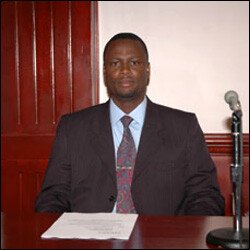
Nigel Carty – Minister of Education
Photo By Erasmus Williams
Basseterre, St. Kitts – Nevis
December 16, 2011 (SKNIS)
The efforts of stakeholders was validated when the certificate declaring St. Mary’s, St. Kitts as a Biosphere Reserve was handed over to the Federation at the 36th Session of the UNESCO General Conference, in early November 2011.
According to UNESCO a Biosphere Reserve is an area “of terrestrial and coastal ecosystems promoting solutions to reconcile the conservation of biodiversity with its sustainable use. They are Internationally recognized, nominated by national governments and remain under sovereign jurisdiction of the states where they are located.” One benefit of a biosphere reserve is that it “can be used as a framework to guide and reinforce projects to enhance people’s livelihoods and ensure environmental sustainability.”
The Department of Physical Planning and Environment in the Ministry of Sustainable Development played a critical role by proposing St. Mary’s as the nomination site in the Federation for the UNESCO Man and the Biosphere (MAB) Programme and followed up by preparing the appropriate mapping for the nomination process.
Austin “Jay” Farier, a Physical Planner of the mentioned Ministry informed the St. Kitts and Nevis Information Service about the next step that would have to be taken.
“To put a management plan in place, that’s first and foremost,” Mr. Farier outlined. “The management plan has to include the community ““ that’s an important characteristic of the Biosphere Reserve, the community involvement, the human development aspect so to say.”
Minister of Education with responsibility for UNESCO, Honourable Nigel Carty mentioned the economic possibilities for the area.
“If we are going to take our tourism to the next level, we need to identify these types of sites,” Minister Carty noted. “I believe that more and more people are going to be looking for what we call eco-tourism. They [tourists] are coming to places where there are reserves ““ with animals and species of plants, perhaps, that don’t exist anywhere else. And the Keys Beach area offers us that kind of opportunity.”
Residents of the area referred to the fact that several decades ago in the 1960s and 1970s St. Mary’s was an established gathering place for residents around the island. Winston “Ebro” Caesar, gave a historical picture of what the area was like.
“From my growing up I always knew that there was picnicking and steel pan playing,” Mr. Caesar reminisced. “This was done in something like our national ware. Our grandparents said they used to dress in similar ways, men and women. And they would go down [to the picnic area] with their basket of food and enjoy their music, have storytelling and a whole lot of community togetherness. So we are looking to see if we can enhance that kind of wholesomeness by our people again.”
Mr. Caesar played an important part in the preparation of the nomination of St. Mary’s which was submitted to UNESCO and stressed the importance of the indigenous plants and wildlife.
While noting the importance of the employment opportunities that the MAB project would foster, Caesar stressed that all activities in the area would have to be carefully monitored and regulated so as not to disturb the delicate balance of nature.
Larry Vaughan, resident of the area and member of UNESCO Small Islands Voice (SIV) noted that it was refreshing that community residents were involved in the process from the initial stages when there was SIV-coordinated consultation involving community stakeholders and training.
“What this had done is it gives a voice to our concerns that would not have normally been given,” Mr. Vaughan stated. “A lot of things happen in these small islands that have not been given the international hearing and understanding. I think that Small Islands Voice, if one thing it has done for our small area of Keys, is to make International that we of the area where there is sea turtle nesting, among other qualities, that makes us environmentally unique. So once you have one of these places [Biosphere Reserve], it should be preserved and SIV has now brought this to the fore.”
Antonio Maynard, Secretary General of the St. Kitts-Nevis National Commission for UNESCO, oversaw the MAB nomination process and recognized the potential of the programme to “contribute to promoting innovative approaches to economic development that is socially and culturally appropriate and environmentally sustainable for a small island developing states.”